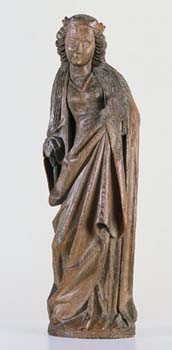A Crowned Female Saint
- ca. 15th century
- Westphalian Workshop (German)
- Carved oak with vestigial traces of polychrome
66.3 x 22.3 x 14.1 cm., 26-1/8 x 8-3/4 x 5-1/2"
- Catherine Carter Goebel, Paul A. Anderson Chair in the Arts Purchase in Tribute to Dr. Mary Em Kirn, Paul A. Anderson Art History Collection, Augustana College 2000.65

Essay by Mary Em Kirn, Professor Emerita of Art History
This gracefully curved statue of a standing female saint is an outstanding example of late Gothic woodcarving in northern Europe. Oak was one of the approved woods based on guild by-laws and until the 1480s, it was common practice to cover the surface with paint (Steyaert 31-34). In fact, surface color was so important that the painters were paid more than the woodcarvers. Thus, this figure originally would have looked quite different than it does today. We can only imagine the brilliant colors, including the probable use of gold leaf, which would have covered the entire surface. Today, small traces of the original red paint are still evident on the back.
Beginning in the early Middle Ages, individual saints began to be identified with attributes or symbols that specifically relate to some aspect of their lives or deaths. The narrow pointed crown circling this figure's head suggests royalty and it was common for female saints from aristocratic backgrounds, such as St. Catherine of Alexandria and St. Barbara, to wear crowns (Hall 40 & 58). However, St. Barbara would also have been identified by the tower she carried and St. Catherine of Alexandria by her wheel and a sword. Unfortunately, this image cannot be identified with a specific saint because her lower arms and attribute are missing.
The original location of this image also remains a mystery. We know that carved statues of both male and female saints were often part of elaborate winged altarpieces created in northern Europe from the mid-14th through 16th centuries (Kuhn 14). Carved saints were also found on contemporary choir stalls and tabernacle shrines.
Experts in late medieval sculpture have difficulty identifying a particular image with a specific geographic area because carvers often moved from place to place, however it has been suggested that this figure is stylistically similar to sculpture from the area of Westphalia. At the beginning of the 19th century, the military occupation of Westphalia by Napoleon resulted in the dissolution of monasteries, the closure of churches and the widespread destruction of religious images. It is possible that this image was removed from its original location at that time.
